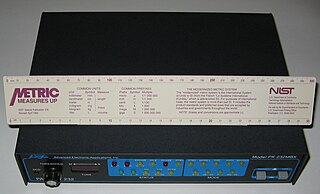
Asynchronous Transfer Mode (ATM) is a telecommunications standard defined by the American National Standards Institute and International Telecommunication Union Telecommunication Standardization Sector for digital transmission of multiple types of traffic. ATM was developed to meet the needs of the Broadband Integrated Services Digital Network as defined in the late 1980s, and designed to integrate telecommunication networks. It can handle both traditional high-throughput data traffic and real-time, low-latency content such as telephony (voice) and video. ATM provides functionality that uses features of circuit switching and packet switching networks by using asynchronous time-division multiplexing. ATM was seen in the 1990s as a competitor to Ethernet and networks carrying IP traffic as, unlike Ethernet, it was faster and designed with quality-of-service in mind, but it fell out of favor once Ethernet reached speeds of 1 gigabits per second.

In telecommunications, RS-232 or Recommended Standard 232 is a standard originally introduced in 1960 for serial communication transmission of data. It formally defines signals connecting between a DTE such as a computer terminal or PC, and a DCE, such as a modem. The standard defines the electrical characteristics and timing of signals, the meaning of signals, and the physical size and pinout of connectors. The current version of the standard is TIA-232-F Interface Between Data Terminal Equipment and Data Circuit-Terminating Equipment Employing Serial Binary Data Interchange, issued in 1997.

Frame Relay is a standardized wide area network (WAN) technology that specifies the physical and data link layers of digital telecommunications channels using a packet switching methodology. Originally designed for transport across Integrated Services Digital Network (ISDN) infrastructure, it may be used today in the context of many other network interfaces.

A data circuit-terminating equipment (DCE) is a device that sits between the data terminal equipment (DTE) and a data transmission circuit. It is also called data communication(s) equipment and data carrier equipment. Usually, the DTE device is the terminal, and the DCE is a modem.
A virtual circuit (VC) is a means of transporting data over a data network, based on packet switching and in which a connection is first established across the network between two endpoints. The network, rather than having a fixed data rate reservation per connection as in circuit switching, takes advantage of the statistical multiplexing on its transmission links, an intrinsic feature of packet switching.

X.25 is an ITU-T standard protocol suite for packet-switched data communication in wide area networks (WAN). It was originally defined by the International Telegraph and Telephone Consultative Committee in a series of drafts and finalized in a publication known as The Orange Book in 1976.
High-Level Data Link Control (HDLC) is a communication protocol used for transmitting data between devices in telecommunication and networking. Developed by the International Organization for Standardization (ISO), it is defined in the standard ISO/IEC 13239:2002.
Packet Switch Stream (PSS) was a public data network in the United Kingdom, provided by British Telecommunications (BT). It operated from the late 1970s through to the mid 2000s.

Link Access Procedure, Balanced (LAPB) implements the data link layer as defined in the X.25 protocol suite. LAPB is a bit-oriented protocol derived from HDLC that ensures that frames are error free and in the correct sequence. LAPB is specified in ITU-T Recommendation X.25 and ISO/IEC 7776. It implements the connection-mode data link service in the OSI Reference Model as defined by ITU-T Recommendation X.222.

A terminal node controller (TNC) is a device used by amateur radio operators to participate in AX.25 packet radio networks. It is similar in function to the Packet Assembler/Disassemblers used on X.25 networks, with the addition of a modem to convert baseband digital signals to audio tones.
A non-broadcast multiple access network (NBMA) is a computer network to which multiple hosts are attached, but data is transmitted only directly from one computer to another single host over a virtual circuit or across a switched fabric.
A FRAD is a device that turns data packets into Frame Relay frames that can be sent over a Frame Relay network and turns the received Frame Relay frames into data packets. Its assembly and disassembly functionality is similar to a packet assembler/disassembler (PAD), which is used for accessing X.25 networks.
Binary Synchronous Communication is an IBM character-oriented, half-duplex link protocol, announced in 1967 after the introduction of System/360. It replaced the synchronous transmit-receive (STR) protocol used with second generation computers. The intent was that common link management rules could be used with three different character encodings for messages.
X.28 is an ITU-T standard specifying the interface between asynchronous character-mode data terminal equipment (DTE), such as computer terminals, and a Packet Assembler/Disassembler (PAD) that connects the DTE to a packet switched network such as an X.25 network.
X.3 is an ITU-T standard indicating what functions are to be performed by a Packet Assembler/Disassembler (PAD) when connecting character-mode data terminal equipment (DTE), such as a computer terminal, to a packet switched network such as an X.25 network, and specifying the parameters that control this operation.
X.75 is an International Telecommunication Union (ITU) standard specifying the interface for interconnecting two X.25 networks.
Packet Layer Protocol or PLP is the network-layer protocol for the X.25 protocol suite. PLP manages the packet exchanges between DTE devices across VCs. PLP also can be used on ISDN using Link Access Procedures, D channel (LAPD).





